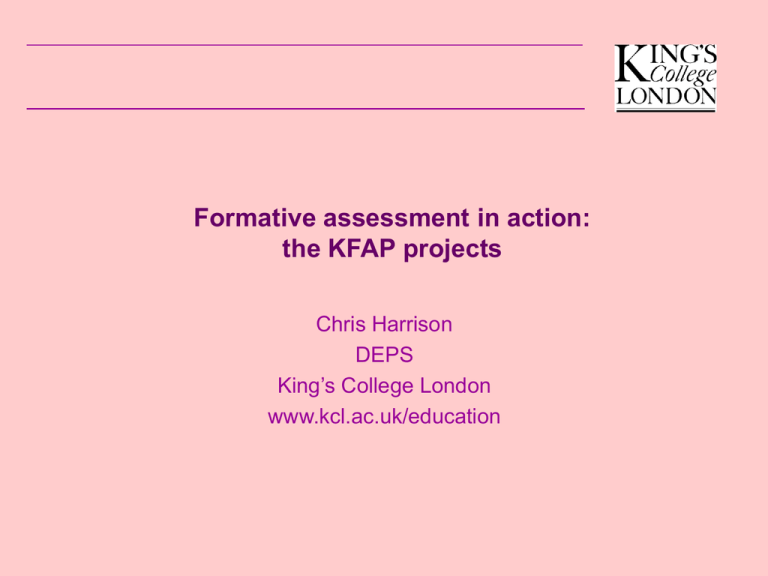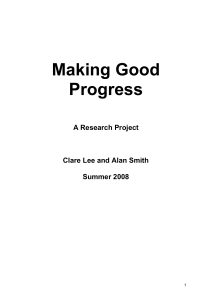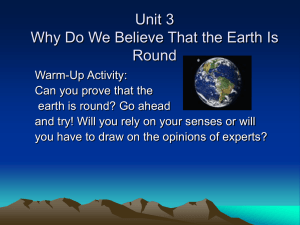Self-assessment
advertisement

Formative assessment in action: the KFAP projects Chris Harrison DEPS King’s College London www.kcl.ac.uk/education Balancing Demands Formative Assessment Summative Assessment Assessment for Learning... Assessment for learning is any assessment for which the first priority in its design and practice is to serve the purpose of promoting learning. It thus differs from assessment designed primarily to serve the purposes of accountability, or of ranking, or of certifying competence. Background • Inside the Black Box (1998) • KMOFAP (1999 - 2001) • Working Inside the Black Box (2002) • Assessment for learning : Putting it into practice (2003) Effect Size • Control & experimental groups • Pre-test & Post-test • Average control gp. scores 10% in pre-test and 45% in post-test • Average experimental gp. scores 10% in pre-test and 60% in posttest • Effect size is EG gain - CG gain range 50 - 35 50 = 0.3 IBB Studies •Effect sizes were between 0.4 - 0.7 but ……. • Studies lacked detail of classroom practice • Short - term • Few were from UK so ……… KMO FAP • King’s Medway Oxfordshire Formative Assessment Project • 2 LEAs, • 3 secondary schools in each, • 2 science and 2 maths teachers in each school (24 teachers in total) • Funded by Nuffield Foundation, and later by United States National Science Foundation through partnership with Stanford Classroom assessment • Four aspects: –Quality of questions –Quality of feedback –Sharing criteria with learners –Self-assessment Making Classroom Assessment Work • the content and pace of the work is determined by the evidence • learning is dependent on the interaction between the teacher and the learner • create environment where errors are made explicit and accepted as a necessary part in moving towards understanding Effects of Feedback • Kluger & DeNisi (1996) • Review of 607 effect sizes (12652 individuals) • Average effect size 0.4 BUT standard deviation almost 1 40% of effect sizes were negative Response to Feedback • Students respond to performance-standard gap in different ways - Abandon it - Change it - Deny it exists - Attempt to reach it Kinds of feedback: Israel (1) • 132 low and high ability year 7 pupils in 12 classes in 4 schools • Same teaching, same aims, same teachers, same classwork • Three kinds of feedback: – marks – comments – marks+comments Comments v Marks • Feedback Gain Interest • marks none top +ve bottom -ve • comments 30% all • both none top +ve bottom -ve +ve • Butler (988) Br. Journal of Psychol 58 1-14 Kinds of Feedback: Israel 2 • 200 Y6 & students • Divergent thinking tasks • 4 matched gps - EG1 (Comments), EG2 (Grades), EG3 (Praise), CG (No feedback). • Achievement • Ego-involvement EG1 > (EG2 =EG3 = CG) (EG2 = EG3) > (EG1 = CG) • Butler( 1987) Looking more deeply at what happens • Hayes (2003) – Two matched year 7 classes – 26 in experimental group, 22 in control group – Study of one term • Strategies – Self Assessment/Reviewing – Target Setting – Discussing Criteria – Looking back at previous work – Doing an Investigation Together – Sharing Good Practice – Looking at and Discussing a Model Investigation Looking more deeply at what happens : Outcomes • Investigations – Experimental group outperforms treatment group – Size of effect equivalent to 0.5 GCSE grade • End of year 7 test – Experimental group outperforms treatment group – Size of effect equivalent to 0.5 GCSE grade • Adaptive beliefs – No change • Maladaptive beliefs – Large reduction • The hard thing is not getting new ideas into their heads. It’s getting the old ones out… Reflections - 2 Motivation and Self-esteem • Those given feedback as marks are likely to see it as a way to compare themselves with others (ego-involvement), those given only comments see it as helping them to improve (task-involvement): the latter group out-perform the former (Butler, 1987). • Students told that feedback “ . .will help you to learn” learn more than those told that “how you do tells us how smart you are and what grades you’ll get” ; the difference is greatest for low attainers (Newman & Schwager, 1995). Reflections - 3 Motivation and Self-esteem • In a competitive system, low attainers attribute their performance to lack of ‘ability’, high attainers to their effort; in a task oriented system, all attribute to effort, and learning is improved, particularly amongst low attainers (Craven et al. 1991). • Feedback given as rewards or grades enhances ego rather than task involvement and can damage the self-esteem of low attainers. We need to change learners’ belief from ‘My IQ is fixed - I’m bright or stupid and that’s it’ to ‘I can get smarter by trying’ (see “Self-Theories” by Carol Dweck, 2000) Kinds of Feedback:Canada • 80 Y9 students learning major scales in music - Experimental group 1 (EG1) given written praise list of weaknesses workplan - Experimental group 2 (EG2) given oral feedback nature of errors chance to correct errors - Control group (CG) no feedback Boulet et al (1990) Kinds of Feedback:Canada • EG2 > EG1 who only achieved about the same as CG Changes in Feedback : Teachers • Teachers have been challenged in composing useful comments that students can and want to read • Teachers have changed their view of the role of written work in promoting student learning • Teachers have had to give more attention to differentiation Changes in Feedback : Students • Students take note of teacher comments and use these to improve their work • Students have changed their perception of the role of written work in learning Self-assessment: Portugal • Maths teachers trained for 20 weeks in promoting pupil self-assessment • Progress of pupils taught by these teachers and other trained teachers (matched in age, qualifications and experience) compared for same mathematics course over same amount of time • Pupils who used self-assessment did TWICE as well as pupils in the other teachers’ classes Pupil Role • Point A ---------------------------------- Point B Recognise points. Close the gap. • Teachers can help with this but only the learner can close the gap • So self-assessment is essential if the gap is to be closed Can learners self-assess? •“ ….a number of pupils ……..….are content to ‘get by’ …….. Every teacher who wants to practise formative assessment must reconstruct the habits acquired by his pupils.” P. Perrenoud (1991) Developing Self Assessment Skills • Understand how criteria play out in different situations • Recognise quality • Open to attempting improvement ……. and these can be achieved through • Peer assessment • Modelling quality/ steps towards quality • Reviewing/Redrafting IBB Classroom assessment • Four aspects: –Quality of questions –Quality of feedback –Sharing criteria with learners –Self-assessment WIBB Classroom assessment • Four aspects: –Quality of questions –Quality of feedback - Peer and Self Assessment - Formative Use of Summative Tests What has KMOFAP achieved • Found a voice for students that have empowered them in their learning • Opened teachers’ ears to their students’ needs • Enabled teachers to find alternative ways to create and support the types of learning environments that result in achievement and develop self-regulation Essential elements • The quality of pupil-teacher interactions • The stimulus and help for students to take active responsibility for their own learning • Collaborative learning Why Has This Intervention Worked? • Teachers and Heads that were willing to take risks • Peer support and reflective practice • Classroom support Contact Details • e-mail : Christine.Harrison@kcl.ac.uk • Web pages http://www.kcl.ac.uk/education/kal.html



![afl_mat[1]](http://s2.studylib.net/store/data/005387843_1-8371eaaba182de7da429cb4369cd28fc-300x300.png)


